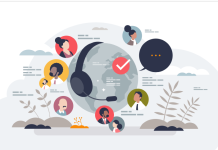
Thank you for calling, your call is important to us, please wait for the next available agent… ♪
The contact center credo is simple: When somebody calls, somebody should answer. As such, ensuring that a sufficient pool of agents is available to competently handle incoming queries at any given time is key to mission success. Too few and customer experience suffers, resulting in both frustrated customers and overwhelmed staff. Too many and operational efficiency suffers, resulting in both excessive expenditures and underutilized expertise.
Finding the right balance is the core concept behind workforce management—a tightly integrated set of organizational processes and procedures designed to optimize the availability and performance of personnel against expected workload.
It sounds simple, but it isn’t. Workforce management draws from and impacts every facet of the enterprise; and it requires more than intuition or mere guesswork to execute well.
Every contact center, large or small, should establish a workforce management team as the cornerstone for organizational planning. Typical areas of responsibility include forecasting, scheduling, real-time management, and reporting and analysis—and each of these areas will influence the others. Compounding complexity are multimedia contact channels that require service—including voice, chat, email, web forms, social media, etc.
In the age of omnichannel customer experience, where many mediums of customer contact must be supported, strategic use of technology helps manage the workforce management processes. As such, there are any number of excellent software solutions available to aid in workforce management endeavors.
When implementing a workforce management system, the most important thing is to ensure is that all tools integrate tightly into (or come part and parcel with) your contact center platform. Assigning or obtaining the right resources skilled in workforce management will maximize the return on investment.
For example, planning is obviously important for creating a consistently performing operation. And one of the best predictors of future behavior is past behavior. Workforce management software allows us to harness data from the past via reporting, then use analytics to prepare and assemble teams for the future via predictive scheduling. Integrated workforce management software in the hands of a skilled team can supply a wealth of information with which to make better organizational decisions:
- Daily volume of customer engagement work types (calls, emails, chats, etc.)
- Forecasts indicating number of interactions of each work type by time and date
- Detailed identification of agent skill sets aligned to forecasts of where they are needed (sales, support, other)
- Customer definitions of appropriate answer speed and answer quality
This type of granular data collectively fuels better workforce management, and promotes greater employee engagement and customer satisfaction. As an organization’s planning skill matures, you should expect to see:
- Improved forecast accuracy
- More efficient scheduling
- More consistency in service delivery
- Ability to accommodate regular quality assurance, training, and other corporate initiatives
- Improved agent morale
- Improved financial performance with control of resourcing requirements
These are all indicators of sound business, and they help ensure that the contact center credo is being fulfilled. Furthermore, contact center workforce management offers benefits to the organization beyond better customer service and agent support. workforce management also serves to stimulate a culture of planning and collaboration, developing a pattern of continuous improvements that will permeate an organization. Well-planned contact centers will deliver strategic value and a competitive advantage.




